In the penultimate installation of my Nashville Predators’ trade deadline targets series, I am looking at the Florida Panthers. Previous installations discussed the Ottawa Senators, New York Rangers and Philadelphia Flyers. With the confirmation that the Senators are going to move Matt Duchene, the possibility of the Predators acquiring him is even more likely. That being said, there are other trade targets out there in case they don’t land Duchene. One of those is the Panthers.
Related: Predators’ Trade Deadline Strategies
The Panthers are a franchise that has failed to get going. In their 25 seasons of existence, they’ve qualified for the postseason five times, including twice in the past 10 seasons. While they reached the 1996 Stanley Cup Final in their third season, it did not lead to sustained success as evident by their 15 head coaches in 25 seasons, including three in the past three seasons.
The positive is that things are turning around for them. They have an owner in Vinnie Viola who is willing to invest in the team and take a methodical approach to establishing a successful franchise. They also have a core that includes Aleksander Barkov, Jonathan Huberdeau, Aaron Ekblad, Vincent Trocheck and Henrik Borgström, all 25 or younger.
Additionally, they have a stocked farm system with Owen Tippett, Grigori Denisenko, Aleksi Heponiemi and Serron Noel. Unfortunately, those elements haven’t equaled NHL success in 2018-19 as the Panthers find themselves in a peculiar situation.
The 2018-19 Panthers
The Panthers currently have a 25-24-8 record with 58 points. That point total has them sixth in the Atlantic Division, tied for 12th in the Eastern Conference and 11 points behind the second wild-card team. They rank 14th in goals for, 27th in goals against, third on the power play, eighth on the penalty kill and last in team save percentage.
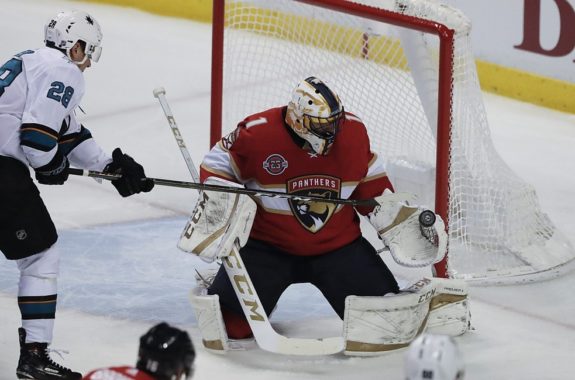
They’re a quality team at forward and on defense, and would likely be in a playoff position if not for poor goaltending with an .895 save percentage (SV%). Roberto Luongo, their veteran starter, has a 12-13-1 record in 30 games with an .895 SV% and a 3.14 goals-against average (GAA). He also has a minus-10.82 goals saved above average (GSAA), a metric that compares a goaltender to the league average netminder.
Luongo’s backup, James Reimer, has a 12-10-5 record in 32 games. He has a .901 SV%, a 3.05 GAA and a minus-6.04 GSAA. Both are bottom-10 in the league in goals saved above average among goalies with at least 30 games played. Both also have at least two seasons left on their contracts.
Related: THW’s Top-10 Trade Deadline Watch List
So that puts the Panthers in a tough position. They are out of the playoffs with little shot to get back into contention, and because they have a relatively young roster that is cost-controlled, they have few sellable assets. They’ve already moved Nick Bjugstad and Jared McCann in what many view was a deal to take a run at Artemi Panarin and Sergei Bobrovsky either at the deadline or in free agency.
There have been rumors that Huberdeau could be available at the deadline, but that seems unlikely and also counterproductive to building a long-term contender. That leaves Mike Hoffman as the only valuable Panther rumored to be available at the 2019 Trade Deadline and who would also make sense to move, as it’s unknown how he fits into the team’s long-term plans.
Mike Hoffman
Hoffman is a 29-year-old left-shot winger with one season left on his contract with a $5.1875 million cap hit. His deal includes a modified no-trade clause in which he can block a trade to 10 teams.
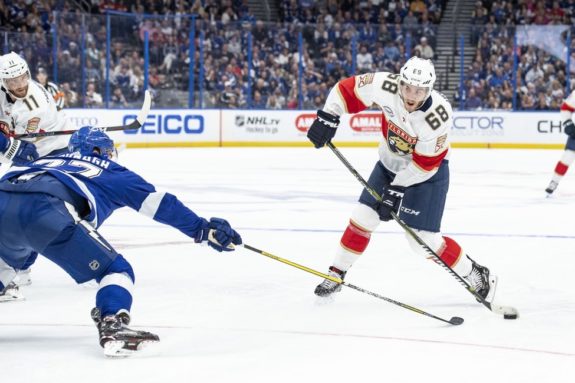
Hoffman in 2018-19
In 57 games this season, Hoffman leads the Panthers with 26 goals and is third on the team with 49 points. He is shooting 14.4 percent, a career high, while skating 17:59 per-game. He’s also a minus-19, but that’s unsurprising given Florida’s poor netminding and how much Hoffman plays.
On a per-game basis, his .46 goals-per-game and .86 points-per-game are career highs and would lead to season totals of 37 goals and 70 points, both of which would surpass his career highs. He’s also attempting 3.16 shots-per-game, a career high and the second straight season the rate has increased.
At five-on-five, he has 12 goals and eight assists while skating 13:16 per-game. He is averaging .95 goals-per-60 (G/60), 1.59 points-per-60 (P/60) and 8.49 shots-per-60 (S/60) while shooting 11.2 percent. He is also generating 6.35 individual scoring chances per-60 (iSCF/60) and 2.7 individual high-danger chances per-60 (iHDCF/60). Those rates are his highest in recent seasons but are below his rates from 2014-15.
This season, Hoffman has mostly played with Barkov and Evgenii Dadonov with 192 shared five-on-five minutes. Together, the trio doesn’t have great metrics, with only their shots for (SF%) and goals for percentages (GF%) at or above 50 percent, and scoring chances for (SCF%) and high-danger chances for percentages (HDCF%) below 50 percent.
|
SF% |
GF% | SCF% |
HDCF% |
|
| Hoffman with Barkov and Dadonov |
50.5 |
50.0 | 49.2 |
44.7 |
| Barkov and Dadonov without Hoffman |
52.4 |
50.0 | 46.3 |
39.5 |
More recently, Hoffman has played on a line with Trocheck and Dadonov, with 25 minutes, which isn’t enough to develop a pattern. Although he has been productive at five-on-five, he has been most lethal on the man advantage and is a big reason the Panthers have the league’s third-best power play.
He has 11 goals and 13 assists on the season, leading the team and tied for sixth in the league in power-play goals. He has been on the ice for 38, or 74.5 percent, of the Panthers’ 51 power-play goals. He is averaging 3:31 per-game, 3.28 G/60 and 7.16 P/60 on the man advantage this season, all career highs. He is also generating 17.9 S/60, 13.4 iSCF/60 and 2.69 iHDCF/60. He plays on the Panthers’ top unit with Barkov, Dadonov, Huberdeau and Keith Yandle, and they have been on the ice for 22, or 43.1 percent, of the team’s power-play goals.
What Would He Bring to the Predators?
It’s pretty obvious that Hoffman’s best asset to the Predators would be his productivity on the power play. His 11 power-play goals would lead the Predators by six and his 13 assists would tie for the team lead. That’s impressive, but it becomes more impressive when broken down into per-60 stats. Of the 13 Predators with at least 50 minutes on the man advantage this season, he would rank first in points, goals and shots, all per-60. He’d also rank third in individual scoring chances per-60 and seventh in individual high-danger chances per-60.
Any help would be welcomed by the Predators, a team that has struggled on the power play all season. As you can see from the heat maps below, the Predators are a minus-20 percent threat relative to league average when on the power play. Meanwhile, the Panthers’ power play is a minus-six percent threat with Hoffman on the ice.
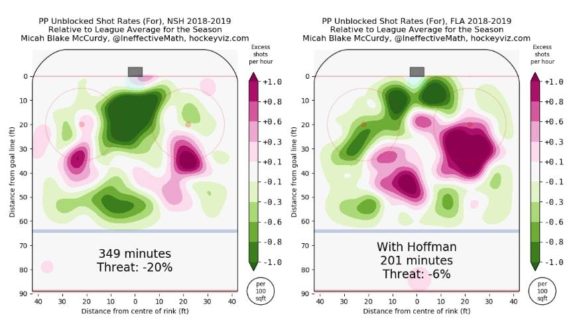
That would be a sizable improvement to the Predators’ power play, but still not ideal. However, there are reasons for Hoffman’s negative threat. For as potent as the Panthers have been on the power play, ranking third in goals-per-60, 14th in scoring chances per-60 and 19th in high-danger chances per-60, they have given up a lot of chances on the man advantage, as well.
This is evident in them being ranked 28th in goals against per-60, 27th in scoring chances against per-60 and 29th in high-danger chances against per-60. Those have resulted in them allowing 10 shorthanded goals, tied for second-most in the league, thanks to an .849 SV% on the power play, third-worst.
But Hoffman is more than just a power-play wizard, he’s also a good five-on-five player. That is best shown by his ability to gain the offensive zone, especially when it comes to carrying the puck, which he does 58 percent of the time. He also averages 25.6 entries-per-60 minutes, well above the league average of 19.3.
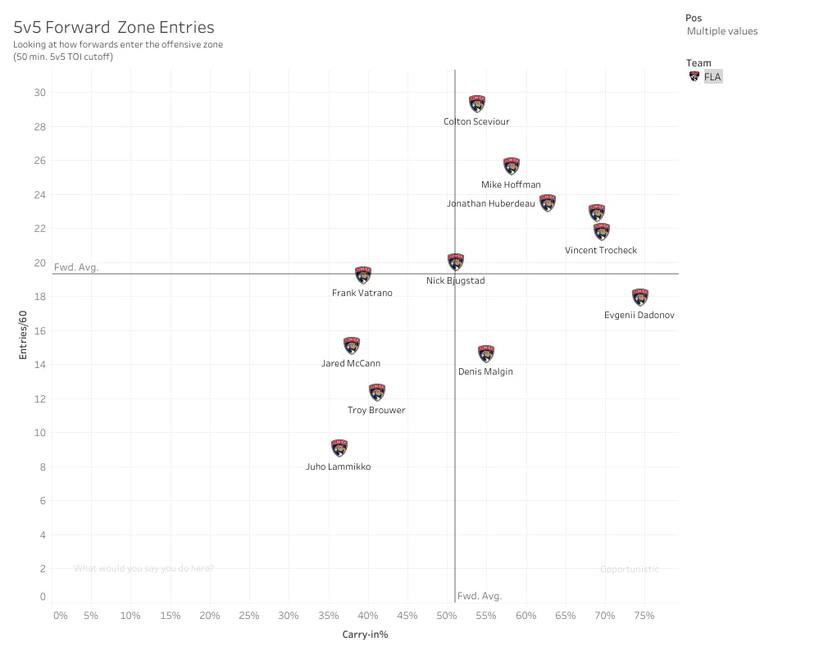
It would also be the highest of any Predator forward as Viktor Arvidsson is currently the team leader with 22.4 entries-per-60. Part of that is due to the Predators entering the zone via pass the majority of the time, but still, having a player who is comfortable entering the zone with the puck on his stick is advantageous.
What Would He Cost?
Considering Hoffman has another season left on his contract, and because the Panthers aren’t chomping at the bit to move him, acquiring him won’t be cheap. That is a big change considering he was dealt twice on June 19, 2018, once from the Ottawa Senators to the San Jose Sharks, and also from San Jose to Florida, with the most valuable asset being either Florida’s 2019 second-round pick or defense prospect Julius Bergman.
Hoffman’s value collapsed during the 2017-18 season due to the combination of off-ice controversy involving his fiance and Erik Karlsson’s wife and the fact that he scored 22 goals, his lowest total since 2013-14. Since then he’s rebuilt his value thanks to a rebound season that has cemented his status as a top-six winger, plus the absence of controversy. As a result, if the Panthers deal Hoffman, they are certain to yield a larger return than either Ottawa or San Jose received.
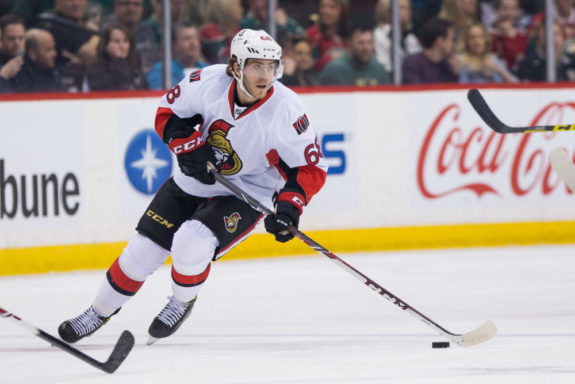
That means acquiring him starts with a first-round pick, but will also require an upper-tier prospect. Perhaps the first-round pick is moved down to a second-rounder if the prospect is considered elite, but it will cost a lot nonetheless. It may seem like a high price to pay, but a team like the Predators, looking for scoring help, especially on the power play, will pay that price for a better shot at a deep playoff run.
This means potentially using top prospect Eeli Tolvanen as the centerpiece. The only issue with that is the Panthers have numerous high-end forward prospects and may be seeking defense prospects. If that’s the case, the Predators’ ability to acquire Hoffman decreases as Dante Fabbro is their only upper-tier defense prospect. However, he’s in college and hasn’t signed his professional contract, so the Panthers would be acquiring his rights, a risky proposition considering he could choose to not sign with them.
Will the Trade Happen?
If the Predators don’t land Duchene, a player they’d likely sign to an extension, or Wayne Simmonds, a playoff rental, they could turn their attention to Hoffman. He isn’t an ideal fit as he wouldn’t provide a net-front presence and isn’t the best two-way player, but he is a consistent scorer who is cost-controlled.
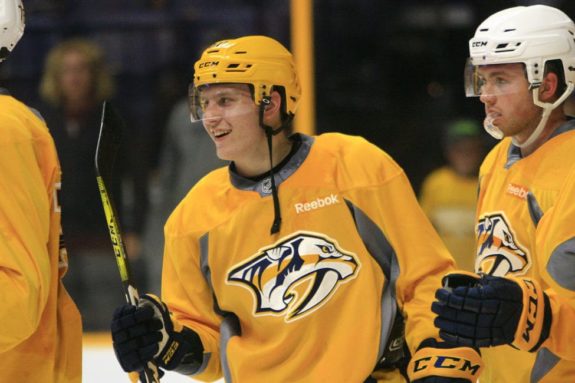
General manager David Poile has mentioned that he isn’t interested in parting with a top prospect unless it means adding a difference-maker, but that’s exactly what Hoffman is. The Predators’ Stanley Cup window is entirely open right now, and it’s time to go all-in on a championship. Hoffman would help with that, and if Poile doesn’t acquire Duchene or Simmonds, landing Hoffman is easy to envision, even if it means parting with a top prospect.
*All stats came from Hockey-Reference, Natural Stat Trick and Corey Sznajder (@ShutdownLine)